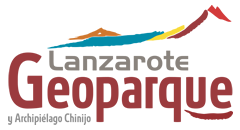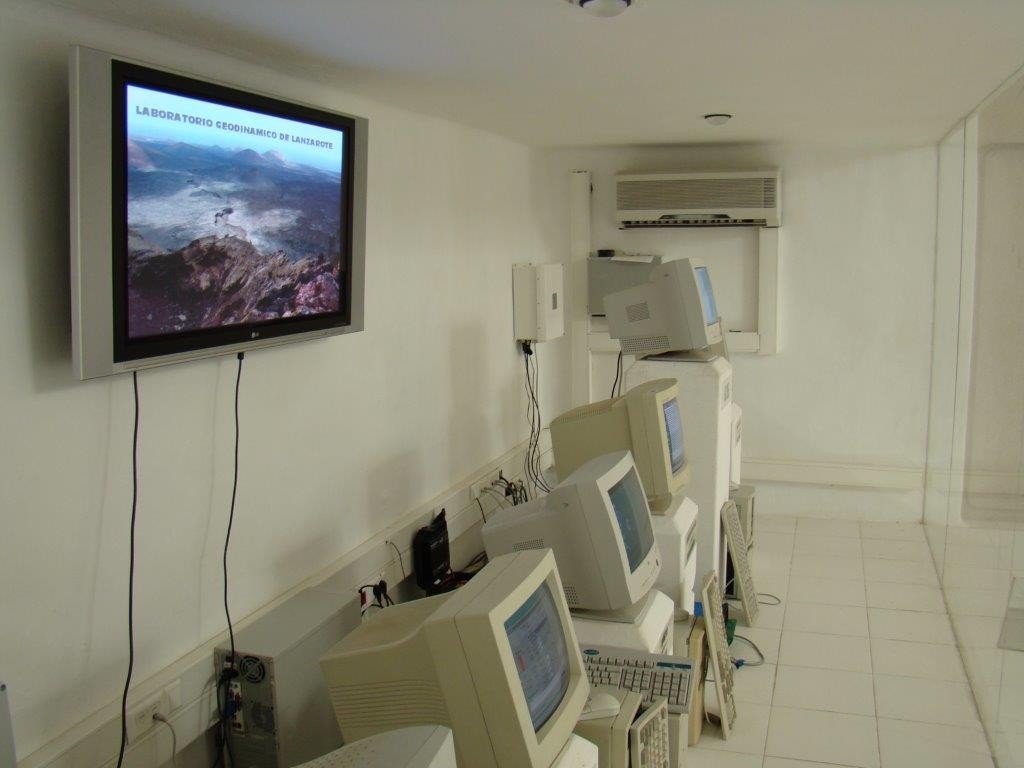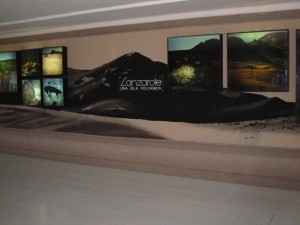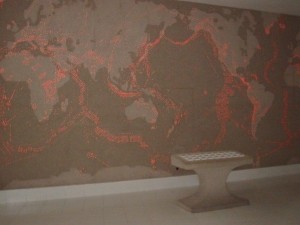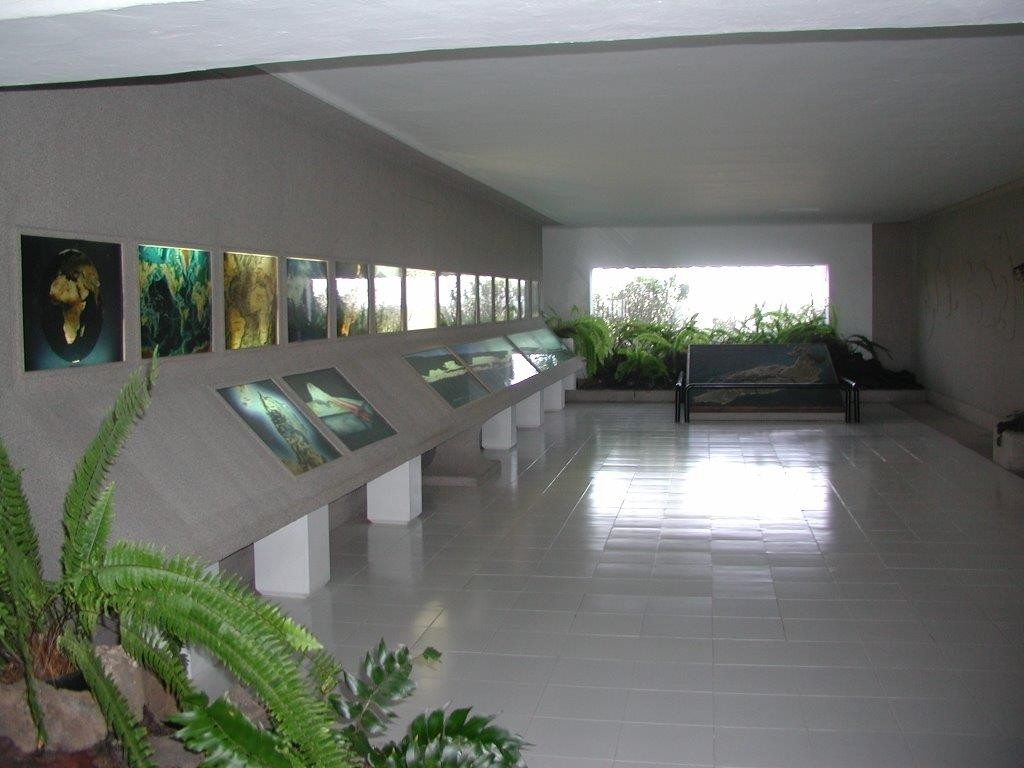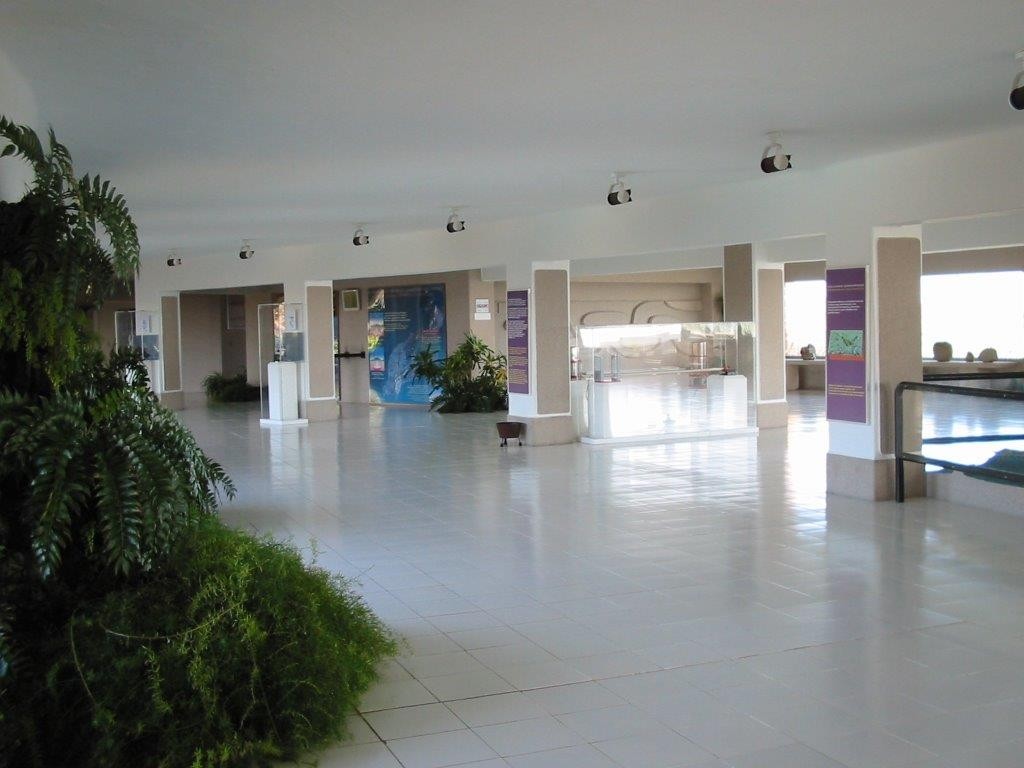Throughout the years, the possibility of creating a centre, that is both dynamic and different to other classic earth science museums in the Canary Islands, was being considered. This museum would allow the development of objectives related to tourism, culture, education as well as dissemination and support to scientific research.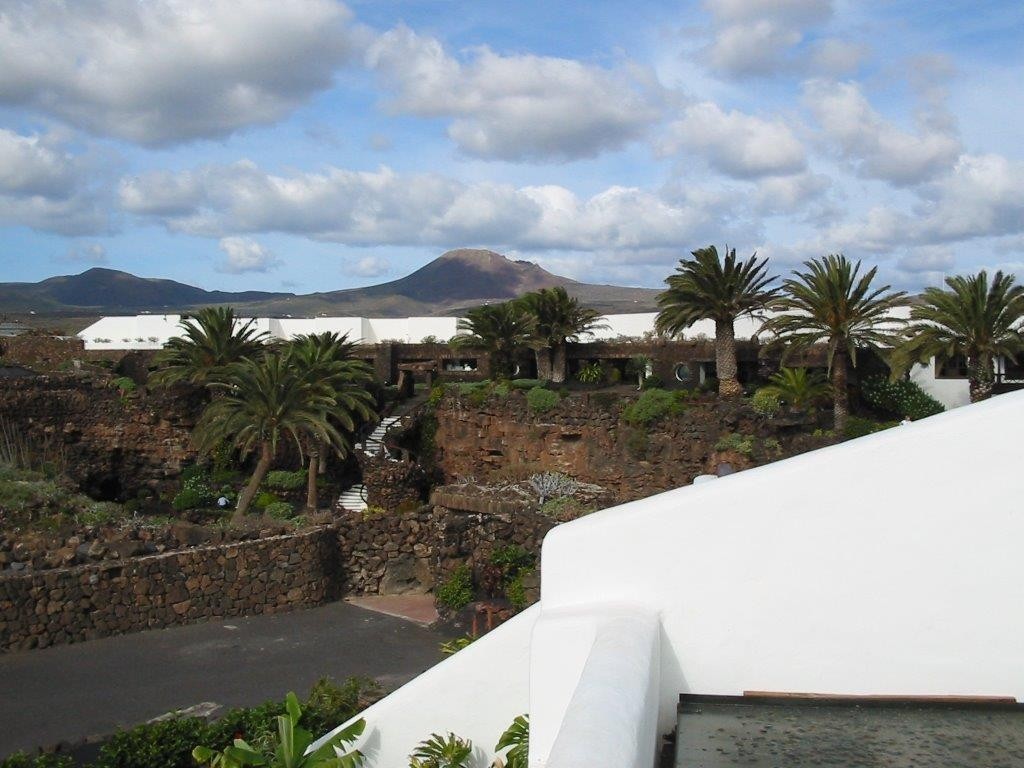
Many reasons supported that idea. The first one of them is the fact that in the Canary Islands everything related to nature is a priority, especially under circumstances in which locals have grown accustomed to living in an active volcanic land. In addition, in the Canary Islands there are unique educational possibilities, not only due to their easy access and numerous visitors, but also because Canarian volcanism is among the most spectacular and varied. The Canary Islands, and more specifically, Lanzarote, have a first-class scientific and cultural heritage. In 1993, Lanzarote was declared a Reserve of the Biosphere and in 2015, a UNESCO Global Geopark as a result of the international recognition of its natural, cultural, scientific and geological features. This project can be seen in Casa de Los Volcanes.
It was in 1987, when the Cabildo of Lanzarote started setting up one of the areas in Jameos del Agua. The idea of installing in these premises the Casa de los Volcanes, came as a consequence of the close friendship of the person in charge of this work (Jesús Soto) with a group of people dedicated to volcanology (Vicente Araña, Ramón Ortíz, Alicia García) who, since the 1970’s, carried out geothermic and volcanological studies in the Canary Islands.
Lanzarote has one of the longest lists of eruptions among other islands. Some of the current rocky massifs come from lava emitted more than 15 million years ago, whereas the latest eruptions took place in 1824.
If we stick to the most recent eruptions, including well-preserved features associated with the current magmatic cycle, we must mention Timanfaya and Montañas del Fuego in the centre and south of the island, which erupted between 1730 and 1736. Also, Volcán de la Corona erupted 25 ka BP 1 in the north.
The lava flow of the latter resulted in a vast karst landscape that reached the sea, from the summit of Famara, creating volcanic tubes, one of them is 7.6 km long, and is possibly the most spectacular one in the Planet; the last 1.6 km are submerged under water nowadays, Túnel de la Atlántida, direct evidence of the global change of sea level during the last glaciation.
The inside of this volcanic tube is uncovered in areas where the ceiling collapsed, making natural access easier; those areas are called “jameos”.
La Corona can be seen through the tube in the stretch known as Jameos del Agua (Fig. 1) and also facing the sea, the Casa de Los Volcanes.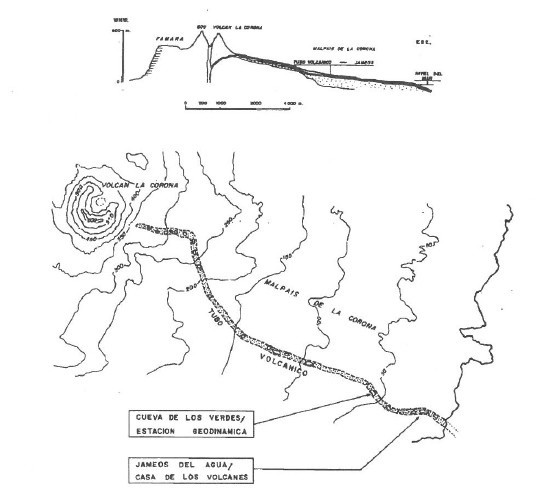
Figura 1. Profile of the Volcán de La Corona volcanic tube and the location of “La Casa de Los Volcanes” over Jameos del Agua.
The Volcán and the Corona Massif, were declared Protected Natural Areas in 1987, as a National Park, and subsequently, in 1994, reclassified as La Corona National Monument and Los Jameos Site of Special Scientific Interest. The features that made this enclave be declared a Protected Area were the following:
- From a geological perspective, the most significant site is the Volcán de La Corona (600 m.a.s.l.) which erupted 25 ka BP. Its lava forms La Corona Massif that goes from the origin of the eruption to the sea, between the towns of Arrieta and Órzola. In addition, in this lava field, tunnels or volcanic tubes were formed from the base of the volcano and into the sea. Cueva de Los Verdes and Jameos del Agua are similar paths in the group of tunnels, that have been set up for visitors. Túnel de la Atlántida is an underwater extension of the same volcanic tube.
- – The vegetation is practically even all over, making the landscape stand out from its surrounding terrain. Over the karst formation there is vegetation of mainly Euphorbia species.
- – The most researched specimen is part of the invertebrate fauna, the blind crab (Munidopsis polymorpha), a species that evolved millions of years ago into an endemic species that adapted to the environmental conditions –especially the darkness- of the volcanic tube.
- Also, there were aboriginal settlements that lived off shepherding and fishing.
Casa de Los Volcanes is a volcanological centre of interest in the areas of culture, education and tourism, based on three basic pillars: the Cabildo of Lanzarote, the Canarian Government and the Volcanology Department of the National Museum of Natural Sciences of the Spanish National Research Council (CSIC, Spanish acronym), with cultural and educational dissemination in mind, as well as scientific promotion in the area of volcanology.
The house avails of the necessary workshop and lab areas to carry out cultural, educational and museum-related activities, as well as support the research conducted by groups of specialised scientists. Its facilities cover 2500 m2 distributed in 2 floors located at the Art, Culture and Tourism Centre (CACT, Spanish acronym) in Jameos del Agua.
The activities at Casa de Los Volcanes are classified as follows:
Scientific
- Seismology and data analysis.
- Scientific data transfer to the Geodynamics Station in Lanzarote.
Educational
- Visits and workshops for students.
- Training and information for teachers.
- School competitions.
Cultural
- Visits for specialised and tourist groups.
- Courses for tour guides, interpreters, etc.
- Information and dissemination campaigns.
There are also documentation, library and video library services available.
Introductory rooms
The people who access the Centre through Jameos del Agua, first of all come across two introductory rooms where they are given information about the location and characteristics of Casa de Los Volcanes.
In the 1st room there are two Jesús Soto murals that portray the unique vision the artist has of transcendental geological events: “The genesis of the atmosphere and life in the evolution of the planet” and “Continents adrift according to the Tectonic Plate Theory”.
In the 2nd room, visitors are reminded that the islands were formed by volcanic materials piling up over the years, mainly underwater. There are also photographs by Ildefonso Aguilar, the genesis and evolution of an island like Lanzarote, and its colonisation by human beings, and finally the settlements and human activity completing the cycle.
Temporary exhibition rooms
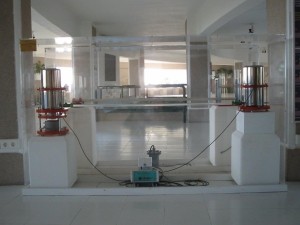 Next, there is a wide gallery open on one side to Jameos del Agua with garden areas, and on the other side the coast can be seen through large windows. This is a diaphanous room and at the same time easy to divide when temporary exhibitions take place.
Next, there is a wide gallery open on one side to Jameos del Agua with garden areas, and on the other side the coast can be seen through large windows. This is a diaphanous room and at the same time easy to divide when temporary exhibitions take place.
There is a large César Manrique mural presiding the gallery overlooking Jameo del Agua. The large windows overlooking the sea are surrounded by other Jesús Soto murals, “Convection currents generated in the planet” and “The opening and expansion of the oceans”.
Canarian rocks
The idea of the creators of this Centre is to reduce the information found in books and other type of museums, interpretation centres, and nature rooms, to a minimum, hence the lack of advertising posters explaining volcanic processes, or showing volcanic rocks displaying names and descriptions. However, under the large windows in the temporary exhibition room, there is a selection of Canarian rocks, especially those that cannot be found in Lanzarote.
Volcanology room
Through the tunnel to the “hall of mirrors” –created by Jesús Soto- you reach the informational area of the Centre. This aims to send visitors a series of messages and give them a series of impressions in order to help them become familiar with some aspects of volcanism in general, specifically in the Canary Islands, as the islands comprise an active volcanic area where volcanic eruptions will continue to take place, although we should not be alarmed by this.
Volcanoes have always been present, and in fact they were the ones to create the Canary Islands millions of years ago; we are the ones who arrived later and have learnt to live with Canarian volcanoes, and it is we that must accept and understand them.
The volcanology room is presided by a large Soto mural, and there is visual information available regarding the following points:
- Location of historic eruptions in groups, sorted by different eras.
- Possible eruptions in the 21st Century.
- Significant earthquakes. Seismic areas.
- Mid-oceanic dorsal.
- Arches of islands. Pacific Ring of Fire.
- Hot spots and the corresponding arrangement of the islands and underwater volcanoes
- Continental rifts
- Observatories and permanent facilities to watch over the eruptions.
- Natural Areas-Heritage of Humanity.
On a screen next to the mural, you may select the summarised information you wish regarding several topics.
There are other two Jesús Soto murals that draw the attention of visitors to the corresponding interactive screens informing visitors about “Geology in the Canary Islands” and about the “Volcanic risk in the Canary Islands”. In these panels, each island is treated individually, including a brief description of their most important elements, from a global to a specific volcanological perspective, as well as using a volcanic risk analysis for each of them.
The variety of Canarian volcanism allows the screen to show the most outstanding aspects of the islands’ geology, showing the different volcanic structures: basalt platform, craters, stratovolcanoes, fields and volcano arrangements, domo, pitons, etc.
The volcanic risk screen also shows the permanent scientific tools used, or that can be used, in the Canary Islands to watch volcanoes (follow-up of eruptions and detecting phenomena such as volcanic seism, deformations of the land, electromagnetic anomalies, gravity variations, unbalance of the chemical composition of gases and volcanic emanations).
Another part of the room is taken by a cabinet displaying the tools that receive the data obtained by thirty sensors part of the research team (seismograph, gravimeter, clinometer, extensometer, oceanographer, thermometer) installed at the Geodynamics Station in Cueva de Los Verdes.
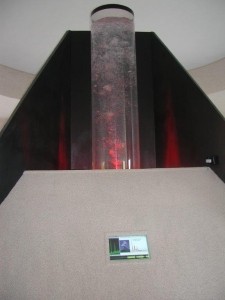
Visitors can see, for example, a registered seismograph provoked by an earthquake happening anywhere in the planet, or identify others that have taken place shortly before. Visitors can also observe the graphic signal of the oceanic or terrestrial waves and watch any possible existing anomalies. In addition, although communication is not direct, in that cabinet there is information regarding any modification taking place at 610 ºC registered by thermocouple installed 12 m deep in the Timanfaya National Park.
Environment rooms
From the back of the temporary exhibition gallery, there is an external corridor that leads to the top floor where there are offices, workshops and other services, such as the library. The top floor has been laid out to hold an environmental theme, by installing some informational panels in different rooms. The common thread in the permanent exhibition in this section of Casa de Los Volcanes is the environmental management on the islands, making special mention to sustainable development. Furthermore, everything related to Reserves of the Biosphere is highlighted, especially its functions and structures in Lanzarote.
Both rooms open up to a panoramic terrace that aims to fully merge the environment with the interpretation of the Centre. The landscape is varied from there, and you can see from the coast to the summit of Famara, and Volcán de La Corona, farming land, coastal towns, ravines, karst formations… the island’s ecosystem overall.
Classroom
The volcanology room leads to a classroom. There is direct access to the classroom from the outside when there are specific activities on, like courses and conferences.
Non-guided visits are the main cultural attraction, as practically everyone going to Jameos del Agua, goes to Casa de Los Volcanes, which means that annually there are more than half a million visitors, of different ages, nationalities and cultural levels and interests. We try to make up for the lack of information tourists come across when visiting other centres, by helping them to quickly familiarise with our user-friendly natural resources.
Casa de Los Volcanes offers their collaboration and premises to Universities, Research Centres, Scientific Institutions, for conferences, meetings, training courses, seminars and workshops. Besides the cultural heritage this contributes to regarding education and research, the most relevant consequence of these actions is the scientific value available in case of an eruptive crisis or possible alarm.
The Casa de Los Volcanes team of scientists, and the Volcanology Department of the MNCN-CSIC, responsible for the Geodynamics Station (IAG-CSIC and UCM, Spanish acronym), are at the disposal of the authorities of Lanzarote, through the Cabildo Insular, to co-operate with Civil Protection authorities in case of crisis or alert. It must be noted that the team is highly experienced when it comes to active volcano activity in other countries, and they work with other corresponding teams regularly. Also, their special dedication to Canarian volcanism shows deep knowledge of the volcanic processes that could take place in Lanzarote, creating models using computerised simulation programmes. In addition, there are ongoing research studies in collaboration with national and international specialists, in order to determine the corresponding signal levels depending on different factors (temperature, gases, and tremors, gravimeter-related…).
As an example of this collaboration, there is the first case study conducted in the Canary Islands using computer simulation for an eruption in Lanzarote. The authorities responsible for Civil Protection took part in this with our volcanology specialists and technical personnel that would be involved should there be a crisis (the army, the airport, hospitals, educational centres, the media…). The result was an efficient first response by the Civil Protection authorities and the correct evacuation drills, means and programmes, supplies…, assisting the population as well as tourists in randomly selected critical conditions.
With regards to availability and operability of this action, which without a doubt contributes to mitigating volcanic risks in the Canary Islands, it is clear that being linked to the team of professionals at Casa de Los Volcanes, it is not necessary to have a special communication protocol with the Cabildo to take part in a volcanic crisis cabinet. Regarding information or contact details, take into account that direct communication is not an issue as it takes place on a daily basis in order to receive the data from the Geodynamics Station, and very frequently for other topics related to the Casa de Los Volcanes and the actions performed by it.
We aim to raise awareness among the people living in the Canary Islands, especially the new generations, and professionals in the field of education, to think of this as their Home one day, to recognise it, use it and value it, and to feel proud of it. This will only happen if they feel that here they get a permanent, truthful, up-to-date and useful reference to a natural phenomenon that created the islands and that we live with: volcanism, extremely important for the Canary Islands.
The location of the Centre in an area that is as attractive for tourists as Jameos del Agua, is open for visitors who are not looking for anything, and who don’t need a typical volcano museum. The aim is to offer visitors –especially since most of them are not from volcanic areas- unique references that make them eager to get to know the condition of the Canary Islands as a natural phenomenon that resulted in the creation of the islands and that affects our lives. Technological innovations and scientific rigour to introduce this knowledge, in an original and attractive manner, that blends in with other CACT centres.
Our objective is to offer support and the necessary facilities for scientific groups to carry out their work on the island, helping us acquire a better understanding of our environment. For instance: the link with the Geodynamics Station of Cueva de Los Verdes; the use of our classrooms and services to hold conferences and meetings of organisations and research teams; publishing scientific papers and their results in the series “Casa de los Volcanes.”
Finally, the scientific infrastructures of the Centre, which guarantees that, in case of a crisis, the authorities on the island would have access to an immediate connection with a team of volcanology professionals familiarised with the specific problems that affect the Canary Islands, and the risks entailed.
